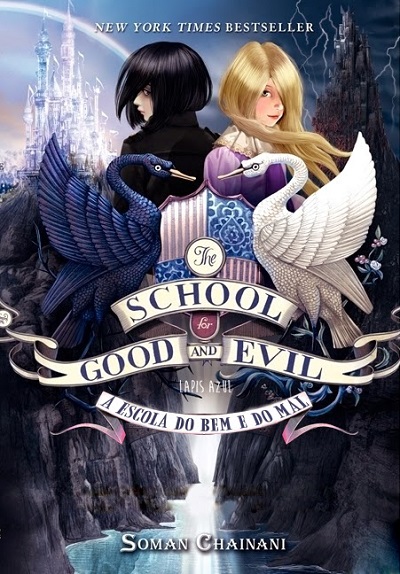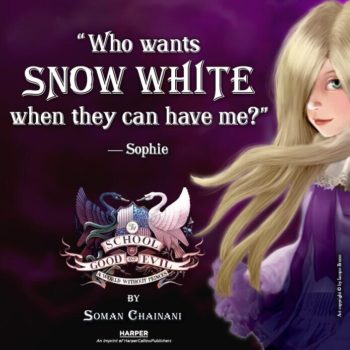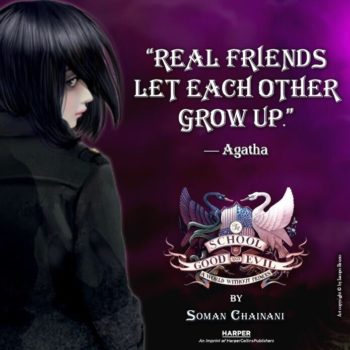
The School for Good and Evil is a 2013 New York Times Best Selling, middle-grade, fairy tale, fantasy novel by Soman Chainani, the first in a trilogy. Sophie and Agatha are an unlikely pair of best friends; where Sophia is bright and beautiful, Agatha is dark and ugly. In their town of Gavaldon, every four years two children are kidnapped by the mysterious School Master and sent to the titular school, where they are trained to be characters in fairy tales of their own. This year it’s Sophia and Agatha’s turn.
If there is any character in this book that I have incredibly strong feelings about, it’s Sophie. I have not come across a character who is so irredeemably despicable since Joffrey Baratheon. Sophie is the absolute worse. She is vain, arrogant, manipulative, dishonest, fake, selfish, ungrateful, never takes responsibility for her choices and actions and their consequences, materialistic…she is positively loathsome.
The novel does off er up some insight into her past, specifically as relates to her parents, but even thought I can understand why it may be that she is this way, the fact of who she is renders me unable to sympathise – or even empathise – with her. She’s just too repulsive a character. There is nothing likeable about her.
er up some insight into her past, specifically as relates to her parents, but even thought I can understand why it may be that she is this way, the fact of who she is renders me unable to sympathise – or even empathise – with her. She’s just too repulsive a character. There is nothing likeable about her.
And then there’s Agatha. These two girls really are the antitheses of each other .
.
Although she can be very sour and mean, particularly in the beginning of the novel, Agatha is sweet, kind, compassionate, genuine, humble, loving, nurturing…everything that Sophie is not. She’s certainly not a perfect character, but she’s definitely more balanced in terms of positive and negative traits than Sophie is.
My favourite characters however are Hester, Anadail and Dot. They are perhaps the most interesting characters in the entire novel and they have a wealth of personality between them.
The twist at the beginning was kind of predictable but the way it unfolded throughout the narrative is indicative of Chainani’s talent in weaving a coherent plot and compelling story. Sophie and Agatha came into their own in very specific ways and their journey was frustrating (in a good way; Chainani succeeded in making me invested in the characters and the story) but satisfying in that it felt earned.
The novel is in some ways a critique and deconstruction of fairy tales. In many ways it follows the typical rules and tropes of a fairy tale – heroes being conventionally attractive and villains being misshapen and hideous – but in others it doesn’t.
It pretty much says at one point that good and evil are not black and white and that everyone is a mixture of both, and the secondary characters tend to reflect that. In fact, the “Good” students have a lot of Sophie’s personality traits and the “Evil” students have a lot of Agatha’s to the point that the “Evil” students are in many ways more “good” than the “Good” students.
Given what happens to students who fail, it makes you question how good “Good” can be when they know what happens and they allow it to; considering that it’s really quite cruel on its own, but also in the light of the fates of these students once they leave the school.
Chainani explores gender roles in fairy tales, especially with the female characters and at The School for Good (The School for Evil has a greater degree of gender equality). A character literally questions the concept of the damsel in distress and the novel on the whole subverts the idea of what and how a princess should be. This is not the crux of the novel, but it is an underlying theme.
The comparisons to Harry Potter, are unavoidable; it is a boarding school where children learn magic, with a school building that is magical in and of itself and has a dangerous forest filled with dangerous magical creatures after all. There’s even something that, as described, is fairly similar to a thestral.
But those are the extent of the similarities for the most part.
With or without the twist in the beginning, if this had been a typical fairy tale, the story would have ended very differently; much in the same way as Snow White or Sleeping Beauty. Such an ending would have been okay – not just to fairy tales but also to the super hero genre. Tragic, but okay. I cannot say if the ending the novel actually has is better, but I appreciate it more because it’s different.
The novel is a little slow; I thought I was around a third of the way into it but it turned out it was more than half. It didn’t feel like the more than mid-way point. It felt more like I was still somewhere in the first act. It took a while to pick up but when it did it really went. Which wasn’t exactly a good thing because the ending felt very rushed and it was very abrupt.
Despite being a children’s books you do not need to be part of the target demographic to enjoy The School for Good and Evil. It is truly an all ages novel that is perfect for parents to read with their children. It’s very well written, with (mostly) likeable characters and has some pretty good messages to boot.
This book is available from:
Amazon
Audible
Barnes and Noble
Book Depository